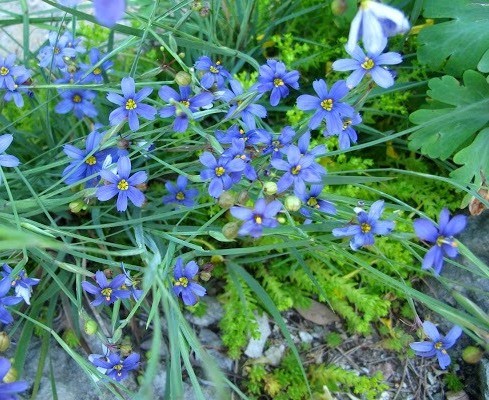Dotted blue-eyed grass
(Sisyrinchium pruinosum)

Description
Sisyrinchium pruinosum, the dotted blue-eyed grass, is a perennial plant in the family Iridaceae, native to the south-central United States. There are also reports of the plant in California, but these appear to represent naturalizations. It is sometimes considered to be a synonym of Sisyrinchium langloisii. Plant: Upright or scrawling, clumped, delicate, smooth perennial 3.5-12 in. (9–30 cm) high; stems slender, usually several, unbranched, flattened, not conspicuously winged as in some species. Flower: up to 1.125 in.(3 cm) across, violet-purple to purple-blue, rarely white, the 6 segments all appearing petal-like, wide-spreading. Flowers usually 1 or a few in cluster at tip of stem, closing during overcast weather. Leaves: up to 9 in.(22.5 cm) long, 125 in.(3 mm) wide, basal, slender, grasslike and flattened like flower stem. Habitat: Clay or sandy clay in open prairies, pastures, meadows, open woodlands and oak uplands. These plants are usually found in abundance and can be spectacular on warm, sunny days where they cover entire pastures with almost solid sheets of blue. They are very beautiful used as borders in the wildflower garden. Sisyrinchium species hybridize readily, often making species identification quite difficult. Sisyrinchium is a large genus of annual to perennial flowering plant in the family Iridaceae. Native to the New World, the species are known as blue-eyed grasses and, though not true grasses and in varieties with flower colors other than blue, are monocots. Several species in the eastern United States are threatened or endangered. These are not true grasses, but many species have the general appearance of grasses, as they are low-growing plants with long, thin leaves. They often grow on grasslands. Many species resemble irises, to which they are more closely related. Most species grow as perennial plants, from a rhizome, though some are short-lived (e.g. S. striatum), and some are annuals (e.g. S. iridifolium). The flowers are relatively simple and often grow in clusters. Many species, particularly the South American ones, are not blue, despite the common name. The genus includes species with blue, white, yellow, and purple petals, often with a contrasting centre. Of the species in the United States, the Western Blue-eyed Grass, Sisyrinchium bellum, is sometimes found with white flowers, while the California Golden-eyed Grass, Sisyrinchium californicum, has yellow flowers.
Taxonomic tree:







